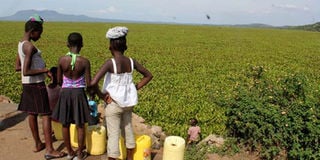Defiant water hyacinth national shame

Children stand beside a section of L Victoria overgrown with water hyacinth. PHOTO | FILE | NATION MEDIA GROUP
What you need to know:
- Millions have been wasted in the name of controlling the weed, without any success, while Uganda and Tanzania have dealt with the menace in record time.
- We must just get remove that weed from the lake; it’s a national shame.
The spate of conferences on the Blue Economy will remain just that, if the country continues ignoring the devastating ecological and economic challenges the water hyacinth poses for the people around Lake Victoria.
The eyesore of the green weed is the highest level of neglect a country can do to its natural resources. Millions have been wasted in the name of controlling the weed, without any success, while Uganda and Tanzania have dealt with the menace in record time.
We must just get remove that weed from the lake; it’s a national shame. The National Blue Economy task force must visit Kisumu, as a matter of urgency and, either through mechanical or biological means flush out the weed, or we need to visit Uganda or Tanzania to learn how they dealt with it.
NEGLECT
The national government and the counties around the lake must deal with the water hyacinth menace once and for all, or somebody should move to the East African Court of Justice to sue them for neglect, and the people who have plundered the resources meant to clean up the lake made to account for the stolen resources.
Despite having the massive Lake Victoria, there is no clean drinking water in the region, no more fishing grounds for locals, the current state of the Winam Gulf in Kisumu, also denies locals their heritage rights.
The lake is being ravaged by the water hyacinth, even with the enacting of the Fisheries Development and Management Act 2016 and the Marine Fisheries Blue Economy strategy. The Fisheries Hydro-acoustics baseline survey of the Territorial Waters of Kenya (12 nautical miles offshore from the shoreline ) done in November 2016 paints a gloomy picture.
CONTROL
Many organisations have made a case for an integrated resource management programme to control the spread of the water hyacinth, while generating energy, restoring soil and water quality, and improving the environment.
What has followed, however, has been wanton wastage of resources and corruption that has seen Winam Gulf, the most affected region in Kisumu, choking to death.
Next week, Kenya will host a global conference on the Blue Economy in Nairobi as a way of showing commitment to the SDGs.
Recently, President Uhuru Kenyatta created the Coast Guards and Marine Force that will be patrolling our water borders to ensure proper use of marine resources.
BLUE ECONOMY
Both Green Growth Economy Strategy and the Blue Economy Strategy paper are an indication of the country’s efforts to actualise the larger circular economy principle, which is part of SDG 12 and to which Kenya a signatory. It has a responsibility to promote proper natural resource utilisation.
Investing in the building blocks can increase profits for the producers, save money for consumers, and improve the environment, boost economic efficiency, and curb carbon development.
Other building blocks of the strategy include transport, and water infrastructure systems.
Mr Bwire is the deputy chief executive of the Media Council of Kenya. [email protected]




